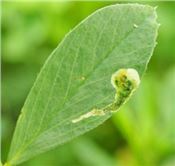Alfalfa Blotch Leaf Miner

Figure 1. Alfalfa blotch leaf miner.
Photo: Lee Townsend, UK
DR. LEE TOWNSEND
LEXINGTON, KY.
A miner is the larval stage of an insect that feeds and develops inside the leaves of its host plants. The alfalfa blotch leafminer (ABLM), a pest of alfalfa in Europe, was discovered in Massachusetts in 1968. The small (1/8 inch long) black fly has spread gradually and can be found in Kentucky.
Damage Caused to Alfalfa
Female flies feed on plant sap that escapes through tiny punctures created as flies insert eggs into leaf tissue. These wounds also can provide entryways for leaf diseases, especially spring black stem. Larvae, which are legless maggots, mine though inner leaf tissue, creating galleries that resemble fat commas with long, narrow tails (Figure 1). A severe infestation of this insect can reduce alfalfa yield by 7 percent to 20 percent and protein content by 10 percent to 20 percent.
Leaf Miner Development
ABLM eggs hatch in 3 to 18 days, depending on temperature. Larvae feed in a leaflet for 1 to 2 weeks, expanding their mines as they grow and consuming about 75 percent of the leaflet area. Full-grown larvae leave foliage, drop to the ground, and pupate, usually within an inch of the soil surface. Adults emerge about 2 weeks later to repeat the process. During the growing season, a generation takes about 30 days. Larvae that pupate in early fall will remain in the soil over winter.
Management Options
• Predators will kill larvae and several small wasps serve as specific biocontrol agents.
• Insecticide applications have not been cost effective in most cases. An average of 250 or more feeding punctures per trifoliate OR more than 30 percent of leaflets with pinholes have been proposed as treatment guidelines, but they have not been substantiated. Incidences of ABLM in two Fayette County alfalfa fields just prior to harvest were well below these levels. ∆
DR. LEE TOWNSEND: Extension Entomologist, University of Kentucky